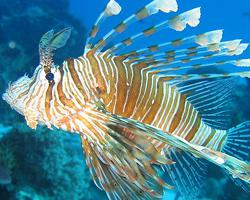
Greutăți și măsuri
| Lungime | de la 30 la 38 cm |
|---|
Descrierea animalului
The red lionfish, Pterois volitans, is a strikingly beautiful but also highly venomous marine fish that belongs to the family Scorpaenidae. This species is native to the Indo-Pacific region but has become an invasive species in the western Atlantic, the Caribbean Sea, and the Mediterranean Sea due to human activity. The red lionfish is renowned for its unique appearance and predatory behavior, which have both contributed to its success as an invasive species and its popularity in the aquarium trade.Physical Description:
The red lionfish is easily identifiable by its bold coloration and distinctive fin rays. It has a compressed, elongated body that can grow up to 15 inches (38 centimeters) in length, though the average size is typically around 12 inches (30 centimeters). The body is adorned with a combination of white, red, maroon, or brown vertical stripes, which serve as an effective camouflage among the coral reefs where it typically dwells.
One of the most notable features of the red lionfish is its array of long, showy pectoral fins that are fan-like and usually banded with contrasting colors. These fins are not only visually impressive but also serve as a warning to potential predators of the lionfish's venomous capabilities. The dorsal fin is equipped with long, venomous spines that can deliver a painful sting to humans and other animals. The anal and pelvic fins also possess shorter spines that are venomous.
Habitat and Distribution:
Originally found in the warm, tropical waters of the South Pacific and Indian Oceans, the red lionfish has a preference for coral and rocky reefs, where it can hide and ambush prey. They are also known to inhabit lagoons, mangroves, and turbid inshore areas. Due to their adaptability, red lionfish have spread extensively outside their native range, establishing themselves along the southeastern coast of the United States, the Gulf of Mexico, and the Caribbean.
Diet and Hunting Behavior:
Red lionfish are carnivorous and primarily nocturnal hunters. They rely on the element of surprise to catch their prey, which includes small fish, shrimp, and crabs. With their wide, gaping mouths, they can create a powerful suction to draw prey in before swallowing it whole. The red lionfish uses its broad pectoral fins to corner and trap its prey, making it difficult for the prey to escape.
Reproduction:
Red lionfish are prolific breeders, which has contributed to their invasive success. Females can release thousands of eggs encased in a gelatinous mass, which are then fertilized by the male. These egg masses float in the water column and can be dispersed by ocean currents, allowing the species to spread over vast distances. The larvae hatch within a few days and are well-equipped to survive in a variety of conditions.
Impact on Ecosystems:
The introduction of red lionfish into non-native ecosystems has caused significant disruption. They are top-level predators with few natural enemies outside their native range, allowing their populations to grow rapidly. This unchecked predation has led to a decline in native fish populations, particularly those of commercial and ecological importance. Efforts to control their numbers include organized culls, promoting them as a food source, and research into natural predators that may help keep their populations in check.
Conservation Status:
In its native habitat, the red lionfish is not considered to be at risk. However, the environmental impact it has when introduced to non-native ecosystems has made its management a conservation priority in affected regions. Education, monitoring, and active management are crucial to controlling the spread and impact of this invasive species.
In conclusion, the red lionfish is an intriguing and complex creature, admired for its beauty yet feared for its venom and its impact on the environments it invades. Its role in marine ecosystems continues to be a subject of intense study and concern among conservationists and marine biologists.
Animale similare
Fotografii noi cu animale
Top 10 animale
- Dolphin gull (Leucophaeus scoresbii)
- Diana monkey (Cercopithecus diana)
- Moustached guenon (Cercopithecus cephus)
- Galápagos tortoise (Geochelone nigra complex)
- Japanese macaque (Macaca fuscata)
- Russian tortoise (Testudo horsfieldii)
- Stone loach (Barbatula barbatula)
- Greek tortoise (Testudo graeca)
- Common flying dragon (Draco volans)
- Vendace (Coregonus albula)


